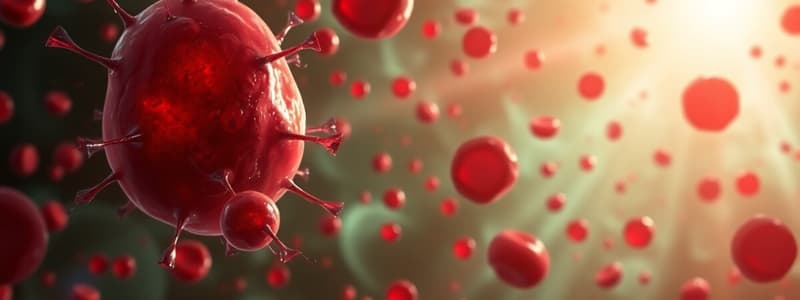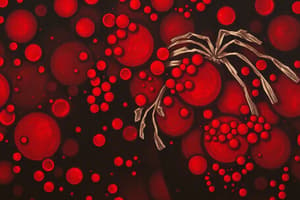Podcast
Questions and Answers
What is the primary function of red blood cells?
What is the primary function of red blood cells?
- Transporting nutrients
- Transporting oxygen (correct)
- Regulating body temperature
- Clotting blood
The ABO blood group system includes blood types A, B, AB, and O.
The ABO blood group system includes blood types A, B, AB, and O.
True (A)
What is the main component of blood that helps in clotting?
What is the main component of blood that helps in clotting?
Platelets
The process of red blood cell production occurs in the ______.
The process of red blood cell production occurs in the ______.
Match the following blood types with their characteristics:
Match the following blood types with their characteristics:
Which blood type is considered the universal donor?
Which blood type is considered the universal donor?
A person with blood type AB can receive blood from any other blood type.
A person with blood type AB can receive blood from any other blood type.
What role do white blood cells play in the body?
What role do white blood cells play in the body?
The measure of red blood cell concentration in whole blood is called ______.
The measure of red blood cell concentration in whole blood is called ______.
What stimulates the production of red blood cells?
What stimulates the production of red blood cells?
What percentage of white blood cells are neutrophils?
What percentage of white blood cells are neutrophils?
White blood cells contain haemoglobin.
White blood cells contain haemoglobin.
What type of white blood cells respond to allergens and kill protozoa and roundworms?
What type of white blood cells respond to allergens and kill protozoa and roundworms?
During the __________ phase of hemostasis, platelets adhere to the sticky endothelial surface.
During the __________ phase of hemostasis, platelets adhere to the sticky endothelial surface.
What is the primary function of monocytes in the blood?
What is the primary function of monocytes in the blood?
Basophils are primarily involved in the coagulation phase of blood clotting.
Basophils are primarily involved in the coagulation phase of blood clotting.
Match the following types of white blood cells to their functions:
Match the following types of white blood cells to their functions:
Name the three phases of hemostasis.
Name the three phases of hemostasis.
White blood cells are also known as __________.
White blood cells are also known as __________.
What distinguishes white blood cells from red blood cells?
What distinguishes white blood cells from red blood cells?
Flashcards are hidden until you start studying
Study Notes
Functions of Blood
- Transports gases, nutrients, hormones, and waste products.
- Regulates pH and ion levels.
- Restricts fluid loss.
- Defends against toxins and pathogens.
- Maintains body temperature.
Components of Blood
- Plasma: Makes up 55% of blood volume.
- Contains water, proteins, electrolytes, nutrients, and gases.
- Plasma proteins include albumins, globulins, and fibrinogen.
- Formed Elements: Make up 45% of blood volume.
- Red Blood Cells (RBCs): Transport oxygen.
- White Blood Cells (WBCs): Fight infections.
- Platelets: Help in blood clotting.
Red Blood Cell Production
- Occurs in the red bone marrow of long bones, particularly the femur.
- Develops from stem cells.
- Takes about a week to mature.
- Production is stimulated by hypoxia (low oxygen levels).
- Iron is recycled at the end of an RBC's lifespan.
Red Blood Cells
- Also known as erythrocytes.
- Measured by hematocrit:
- Separates blood into layers by centrifuging.
- RBCs at the bottom, plasma on top.
- Normal values: Male 46%, Female 42%.
Blood Groups
- Classified by the ABO and Rh groups.
- Determined by surface antigens on red blood cells.
- Type A: A antigen only.
- Type B: B antigen only.
- Type AB: Both A and B antigens.
- Type O: Neither A nor B antigens.
- Rh surface antigen:
- Present (Rh+) or absent (Rh-).
- Combined to give blood groups like A+, B-, etc.
Blood Donation/Transfusion
- Type O: Universal donor, lacking A and B antigens, minimizing reactions with recipient plasma.
- Type AB: Universal recipient, lacking A and B antibodies, tolerating most donated blood types.
- Blood is usually cross-matched before donation:
- Exposing donor RBCs to recipient plasma to check for reactions.
White Blood Cells
- Also known as leukocytes.
- Several types: Neutrophils, eosinophils, basophils, monocytes, and lymphocytes.
- Possess a nucleus.
- Lack hemoglobin.
- Some can migrate out of the bloodstream.
- Exhibit ameboid movement.
- Attracted to specific chemical stimuli.
Types of White Blood Cells
- Neutrophils: Most abundant WBCs, phagocytic towards bacteria, and digest them.
- Eosinophils: Respond to allergens, kill protozoa, and roundworms.
- Basophils: Accumulate in damaged tissues, promoting inflammation.
- Monocytes: Large, engulfs debris and pathogens.
- Lymphocytes: T cells, B cells, and NK cells.
Clotting Mechanism (Hemostasis)
- Three phases: vascular, platelet, and coagulation.
- Vascular Phase:
- Cutting a blood vessel triggers vascular spasm and endothelial changes to make the vessel sticky.
- Platelet Phase:
- Platelets adhere to the sticky endothelial surface.
- Rapid platelet buildup.
- Coagulation Phase:
- Delayed phase, involving a complex series of reactions.
Summary
- Blood is composed of plasma and formed elements.
- Blood transports substances, regulates body functions, and defends against infections.
- Red blood cells transport oxygen, and their production is regulated by oxygen levels.
- Blood type is determined by surface antigens and antibodies.
- White blood cells protect against infections through various mechanisms.
- Hemostasis (blood clotting) is a complex process with three phases.
Studying That Suits You
Use AI to generate personalized quizzes and flashcards to suit your learning preferences.



